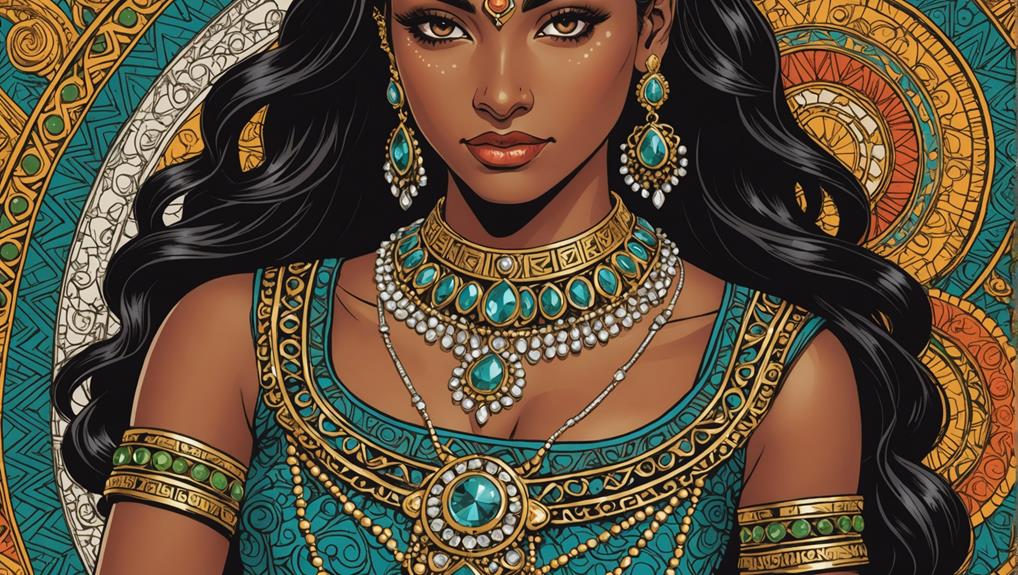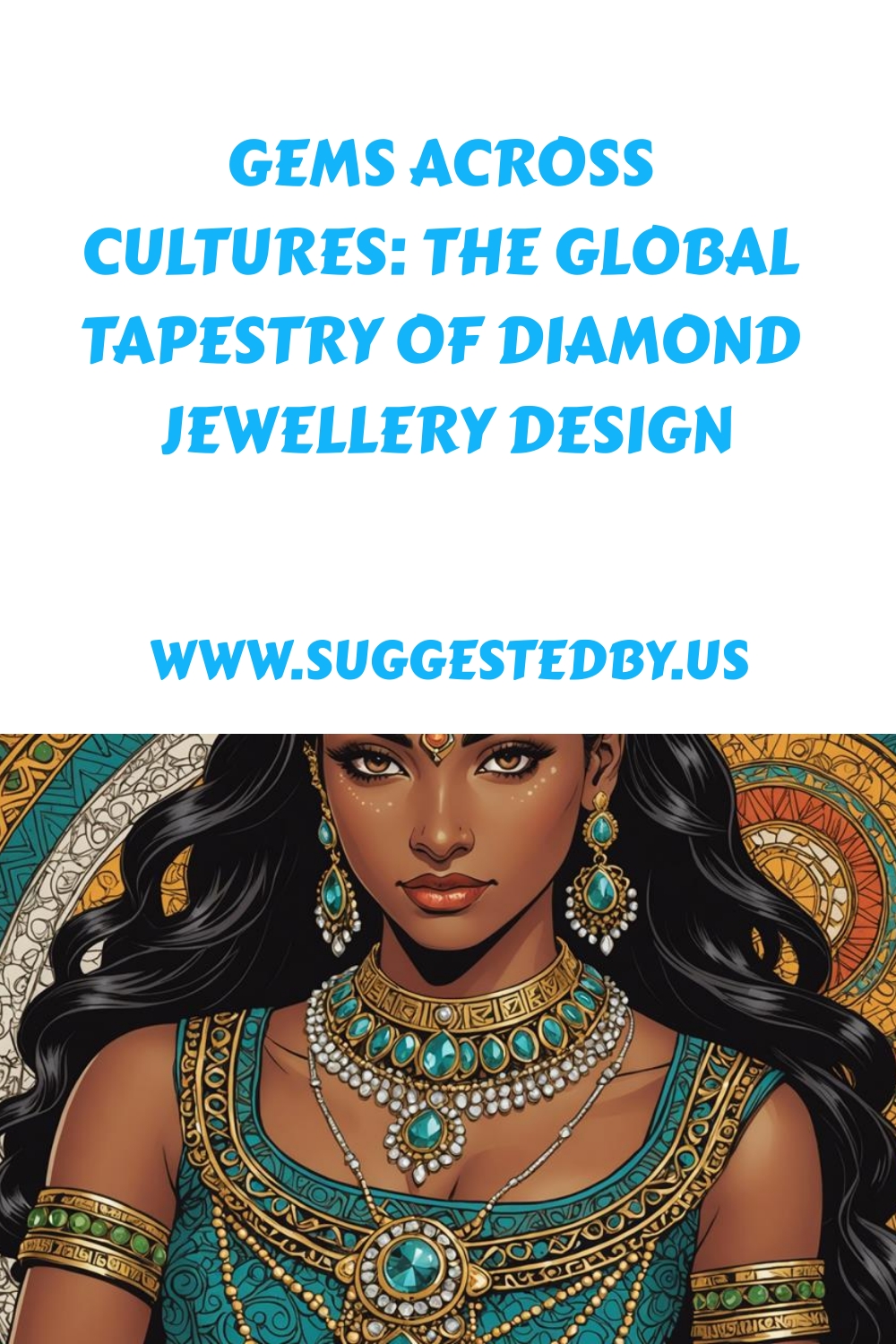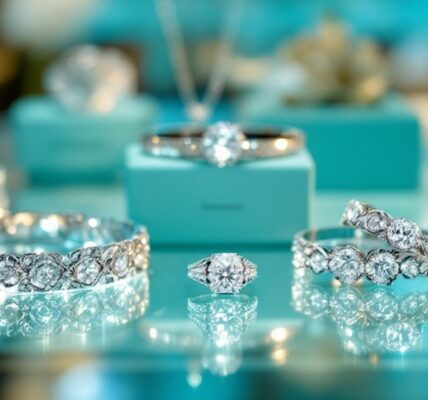Gems Across Cultures: The Global Tapestry of Diamond Jewellery Design
Diamond jewellery holds profound significance across various cultures, symbolising power, heritage, and artistry.
The intricate designs and traditional craftsmanship of diamond pieces from different regions reflect this universal allure.
The global interconnectedness of cultures has further enriched these designs, creating a tapestry of creativity and elegance that transcends borders and eras.
Article Contents
- 0.1 Overview of the Significance of Diamond Jewellery in Our Cultures
- 0.2 Global Interconnectedness Influences Jewellery Designs
- 1 Main Highlights
- 2 The Role of Cultural Heritage in Jewellery Design
- 3 Indian Jewellery: Tradition Meets Opulence
- 4 African Jewellery: Symbols of Identity and Heritage
- 5 Japanese Jewellery: Minimalism and Precision
- 6 Modern Interpretations and Fusion in Jewellery Design
- 7 Bridging Cultures: Fusion Jewellery
- 8 The Influence of Pop Culture and Fashion Trends
- 9 From the Red Carpet to the Catwalk: Diamonds in Pop Culture
- 10 Sustainability and Ethical Considerations in Jewellery Design
- 11 Ethical Diamonds: A New Age of Conscious Design
- 12 Technological Advancements Shaping Jewellery Design
- 13 The Digital Craft: 3D Printing and Laser Cutting
- 14 Our Conclusions and Final Thoughts
- 15 Frequently Asked Questions
- 16 Further Reading About Cultural Influences on Jewellery Design
Overview of the Significance of Diamond Jewellery in Our Cultures
Across diverse cultures, diamond jewellery holds profound significance, symbolising attributes such as love, purity, and eternal commitment. This symbolism varies with each society that cherishes diamonds.
In Indian culture, diamonds signify wealth, power, and spiritual enlightenment. Chinese traditions praise diamonds for their rarity, representing strength, resilience, and prosperity.
In African cultures, diamonds in jewellery symbolise status, beauty, and ancestral lineage. Western societies often view diamond jewellery as representations of commitment, luxury, and sophistication.
The global influences shaping these perceptions blend traditional aesthetics with contemporary styles, creating a rich tapestry of meanings and interpretations.
Consider the following cultural nuances:
- Indian culture: Wealth, power, spiritual enlightenment
- Chinese culture: Strength, resilience, prosperity
- African cultures: Status, beauty, heritage
- Western societies: Commitment, luxury, sophistication
- Historical artefacts: Intricate designs, enduring allure
This multifaceted appreciation of diamond jewellery underscores its universal appeal, transcending geographical boundaries and historical epochs. Through this lens, we observe how the significance of diamonds continues to evolve, reflecting both ancient traditions and modern innovations in jewellery design.
Global Interconnectedness Influences Jewellery Designs
The intricate significance of diamond jewellery in various cultures seamlessly intertwines with global interconnectedness, shaping contemporary designs. This interconnectedness characterises a rich tapestry of cultural exchange and creative inspiration, where artisans draw from global influences and design evolution. Historical connections inform modern trends, breathing new life into age-old traditions and motifs.
Today’s diamond jewellery often incorporates symbolic motifs from diverse cultures, creating pieces that resonate with a broader audience. This fusion of aesthetics highlights how diverse influences converge, resulting in unique and universally appealing masterpieces. For instance, the intricate patterns of Indian Mughal jewellery may blend with the minimalist elegance of Scandinavian design, creating an innovative juxtaposition that appeals to connoisseurs worldwide.
Cultural exchange plays a pivotal role as jewellers travel and communicate across borders, bringing back both tangible materials and intangible inspirations. These interactions enrich the global tapestry of diamond jewellery design, ensuring each piece tells a story of interconnectedness and shared heritage. Thus, the world of diamond jewellery becomes a canvas where tradition and modernity coalesce, showcasing a harmonious blend of cultural aesthetics and symbolism.
Main Highlights
- In Indian culture, diamond jewellery symbolises wealth, power, and spiritual enlightenment.
- African diamond jewellery incorporates tribal motifs, signifying status and heritage.
- Japanese diamond jewellery emphasises minimalist elegance and natural beauty.
- Modern jewellery designs merge traditional motifs with contemporary aesthetics.
- Increasing consumer demand for ethically sourced and sustainable diamonds influences the global jewellery market.
The Role of Cultural Heritage in Jewellery Design

Cultural heritage significantly impacts the aesthetics and symbolism of diamond jewellery, with historical and cultural contexts influencing design principles in different regions.
For example, Indian diamond jewellery often showcases intricate patterns and vibrant colours inspired by Mughal artistry.
African designs frequently incorporate tribal motifs and natural elements, reflecting the rich cultural diversity of the continent.
In Japan, the minimalist beauty of traditional craftsmanship is evident in the refined elegance of diamond pieces, demonstrating a deep reverence for nature and simplicity.
How Historical and Cultural Backgrounds Influence the Aesthetics of Jewellery
Historical and cultural backgrounds profoundly shape jewellery aesthetics by embedding traditional symbols, materials, and techniques into the design process. This fusion of cultural symbolism and historical influences creates unique design aesthetics that resonate deeply with various societies. By studying the historical and cultural contexts of different societies, jewellery designers can uncover antique jewelry secrets and incorporate them into modern designs. These newly discovered techniques and symbols add a layer of depth and richness to the aesthetics of the jewellery, creating pieces that tell compelling stories and hold special meaning for those who wear them. In this way, the influence of historical and cultural backgrounds continues to shape and inspire the world of jewellery design.
Jewellery, as an artistic expression, often reflects the values, beliefs, and customs of its culture of origin, making each piece a reflection of its heritage.
Key elements that influence jewellery design include:
- Intricate motifs inspired by folklore and mythology
- Use of region-specific gemstones and metals
- Traditional crafting techniques passed down through generations
- Incorporation of religious and spiritual symbols
- Designs inspired by historical events and figures
The interplay between cultural heritage and jewellery design is evident in the way artisans draw from their rich historical backgrounds to create beautiful and meaningful pieces. Traditional techniques such as filigree, enamelling, and granulation are not merely methods of craftsmanship but also ways to preserve and celebrate cultural identity.
These design elements ensure that jewellery pieces are visually appealing and culturally significant. Through these artistic expressions, the global tapestry of jewellery design continues to evolve, paying homage to the past while embracing contemporary influences.
Examples From Various Cultures (Indian, African, and Japanese)
Diamond jewellery designs from various cultures, such as Indian, African, and Japanese, vividly illustrate how cultural heritage shapes aesthetic choices and craftsmanship. Indian diamond jewellery, renowned for its intricate patterns and vibrant colours, embodies centuries of cultural symbolism and traditional influences. These pieces often feature motifs inspired by nature and mythology, showcasing the country’s rich artistic legacy through elaborate and ornate designs.
African diamond jewellery, on the other hand, stands out for its earthy tones and traditional motifs that draw inspiration from the history and spirituality of the continent. The incorporation of natural elements and tribal patterns gives these pieces a profound sense of cultural symbolism and ancestral reverence. This fusion of traditional influences and contemporary design creates a unique aesthetic that resonates globally.
Japanese diamond jewellery, in contrast, is defined by minimalist elegance and precision. These designs place an emphasis on simplicity and subtlety in keeping with the nation’s culture of refinement and craftsmanship. The minimalist approach not only accentuates the natural beauty of the diamonds but also aligns with global aesthetics that favour understated luxury.
As a result, the global tapestry of diamond jewellery design, rich with various cultural influences, showcases a harmonious blend of tradition and modernity, producing pieces that are both timeless and universally appealing.
Indian Jewellery: Tradition Meets Opulence

Indian jewellery embodies a seamless fusion of tradition and luxury, with intricate designs and vibrant gemstones creating masterpieces that reflect the nation’s rich cultural heritage.
Deeply embedded in religious and social ceremonies, these exquisite pieces serve as symbols of significant life milestones.
The meticulous craftsmanship, evident in detailed filigree work and vibrant gemstone arrangements, highlights India’s exceptional artistic talent and deep-rooted appreciation for symbolism and spirituality.
Description of Traditional Indian Jewellery Styles and Their Cultural Significance
Traditional Indian jewellery, with its intricate designs and cultural symbolism, exemplifies the richness and heritage of diverse Indian communities. Each piece reflects India’s rich cultural heritage, employing symbolic motifs that convey spiritual significance and historical narratives.
The craftsmanship varies by regional styles, each with unique techniques and aesthetic principles.
- Kundan jewellery: Renowned for its use of uncut diamonds set in pure gold, reflecting royal opulence.
- Meenakari work: Known for its vibrant enamel designs, often depicting floral and animal motifs.
- Polki diamonds: Uncut diamonds set in intricate patterns, maintaining a raw, traditional allure.
- Temple jewellery: Inspired by deities and temple architecture, primarily used in classical dance forms and spiritual rituals.
- Jadau craftsmanship: A Mughal-era technique involving the embedding of precious stones into gold, often featuring elaborate designs.
The use of materials such as gold, gemstones, and enamel highlights the luxurious essence of traditional Indian jewellery. These pieces serve as adornments and cultural artefacts, preserving centuries-old traditions and regional identities. Their spiritual significance and symbolic motifs make them more than mere accessories; they are embodiments of India’s profound cultural and historical legacy.
Influence of Religious and Social Ceremonies on Jewellery Designs
The deep influence of religious and social ceremonies on Indian jewellery designs is evident in the intricate patterns and symbolic motifs that adorn these exquisite pieces. Indian jewellery, deeply rooted in cultural aesthetics, reflects the country’s rich heritage by blending traditional opulence with meaningful symbolism.
Common religious motifs such as lotus flowers, peacocks, and elephants carry significant meanings within Hinduism and other local religions. These motifs are not simply decorative but represent divine attributes, prosperity, and wisdom.
Social ceremonies, particularly weddings and festivals, play a crucial role in shaping jewellery designs. Elaborate pieces like Kundan, Meenakari, and Jadau adorn brides, symbolising familial bonds and social status. The craftsmanship involved showcases a meticulous fusion of tradition and artistry, where every piece tells a story of cultural heritage passed down through generations.
The reverence for traditional opulence is evident in the use of precious stones and metals, transforming each piece into a wearable heirloom. Thus, Indian jewellery is not just an accessory but a cultural artefact, reflecting the intricate interplay of religious and social elements that define its unique and timeless allure.
African Jewellery: Symbols of Identity and Heritage

African jewellery is renowned for its use of natural materials and bold designs. It embodies profound cultural meanings and reflects the rich heritage of diverse tribal communities.
These intricate pieces are often crafted from beads, shells, and organic elements. They are not mere adornments but symbols of identity and spiritual beliefs.
Each region’s unique traditions and motifs highlight the deep connection between the wearers and their ancestral lineage, showcasing the continent’s vibrant artistic legacy.
Use of natural materials and striking designs in African jewellery
Rich in heritage and symbolism, African jewellery utilises natural materials and bold designs to convey cultural identities and beliefs. Using symbolic motifs and vibrant colours, these adornments narrate the stories of various ethnic groups, embodying community identification and cultural preservation.
Handcrafted techniques such as beadwork, wirework, and metal casting are meticulously passed down through generations, ensuring that each piece is both an accessory and a demonstration of ancestral artistry.
African jewellery often incorporates:
- Beads made from glass, clay, and seeds, each chosen for their unique meanings.
- Intricately carved shells and stones, symbolising a connection to the earth and sea.
- Metals like copper and brass, moulded into bold shapes that signify strength and resilience.
- Brightly coloured textiles and threads, woven into designs depicting social status and heritage.
- Organic elements such as wood and bone, adding layers of historical and spiritual significance.
These materials and designs are more than mere adornments; they serve as powerful mediums for cultural expression and preservation. They reinforce community bonds and offer a visual lexicon through which African societies communicate their rich and diverse traditions.
Cultural meanings embedded in tribal jewellery designs
Building on the use of natural materials and bold designs, the cultural meanings embedded in tribal jewellery designs reveal a profound connection to identity, heritage, and spirituality. African jewellery is not merely a form of adornment; it serves as a vehicle for cultural storytelling, encapsulating the traditions and beliefs of various tribes.
Symbolic motifs, such as geometric patterns and animal representations, are prevalent. Each has unique connotations that reflect the wearer’s social status, spiritual beliefs, and ancestral connections. Tribal influences significantly impact the intricate crafting of these pieces, with each community boasting unique styles and techniques.
For instance, the Maasai of Kenya and Tanzania are renowned for their vibrant beadwork, which signifies age, marital status, and social standing. Similarly, the Tuareg people of the Sahara Desert incorporate intricate silverwork, often imbued with protective symbols.
Meaningful adornment in African jewellery transcends mere aesthetic appeal, serving as a tangible link to the past and an affirmation of the resilience and continuity of cultural heritage. By wearing these pieces, individuals honour their ancestors and perpetuate a rich tradition of artistry and symbolism that speaks volumes about their collective identity.
Japanese Jewellery: Minimalism and Precision

In the world of Japanese jewellery design, the principles of Wabi-Sabi—celebrating the beauty of imperfection and transience—are fundamental. This aesthetic philosophy is apparent in diamond pieces that focus on simplicity, natural beauty, and careful craftsmanship.
With a strong dedication to accuracy and quality, Japanese designers expertly combine traditional elements with contemporary minimalism, producing subtle yet elegant jewellery.
The Influence of Japanese Aesthetics Like Wabi-Sabi on Jewellery Design
Japanese jewellery design, deeply influenced by the aesthetic principles of Wabi-Sabi, expertly highlights simplicity, imperfection, and natural beauty. Rooted in a profound appreciation for the transient and the flawed, Wabi-Sabi celebrates these elements as crucial to genuine beauty and elegance. This philosophy is evident in several distinct aspects that characterise Japanese jewellery design:
- Embracing imperfection: Japanese jewellers welcome flaws, incorporating asymmetry and irregularities to showcase the unique character of each piece.
- Drawing inspiration from nature: Designs often take cues from nature, mirroring organic shapes and textures that exude refined simplicity.
- Exacting craftsmanship: Artisans display unparalleled precision and attention to detail, ensuring each creation embodies technical mastery and understated sophistication.
- Natural materials: Materials like wood, bamboo, and natural stones are frequently utilised, fostering a harmonious link between the jewellery and the natural world.
- Genuine beauty: The aesthetic values authenticity, highlighting the inherent charm found in the raw and unrefined.
These elements combine to produce pieces that are not only visually impactful but also resonate with deeper philosophical significance.
The Japanese approach to jewellery design, with its unique combination of precise craftsmanship and organic unity, provides a compelling testament to the enduring appeal of Wabi-Sabi.
Emphasis on Simplicity and Natural Beauty
Reflecting the cultural value of simplicity and natural beauty, Japanese jewellery design emphasises minimalism and precision. It often incorporates elements of nature, such as cherry blossoms and bamboo. The influence of Japanese aesthetics is evident in the clean lines and geometric shapes that characterise these pieces, showcasing a minimalist beauty that resonates with cultural simplicity.
Japanese artisans excel in precision, ensuring each piece of diamond jewellery is both aesthetically pleasing and meticulously crafted. This attention to detail results in exquisite creations that embody natural elegance, inspired by the understated beauty of the natural world.
A hallmark of Japanese jewellery design is the incorporation of the ‘wabi-sabi’ philosophy, which appreciates the beauty in imperfection and the passage of time. This concept adds depth and uniqueness to each piece, seamlessly integrated into their work.
The natural elegance of Japanese diamond jewellery, coupled with its minimalist beauty, offers a refreshing contrast to more ornate styles, highlighting the sophistication of cultural simplicity.
Ultimately, Japanese jewellery design represents a harmonious blend of tradition and modernity, where precision and an appreciation for natural beauty create timeless pieces.
Modern Interpretations and Fusion in Jewellery Design

In contemporary diamond jewellery design, designers skillfully merge traditional motifs with modern aesthetics, creating innovative and timeless pieces.
These creations integrate diverse cultural symbols, materials, and techniques influenced by globalisation, resulting in a harmonious fusion that appeals to a global audience.
This blend of heritage and modernity honours the past and celebrates the present, showcasing the dynamic evolution of diamond jewellery.
How Contemporary Designers Blend Traditional Motifs With Modern Styles
Contemporary jewellery designers expertly blend traditional motifs with modern styles, creating unique pieces that honour cultural heritage while embracing innovative design. This cultural fusion is evident in how designers seamlessly integrate symbolic motifs and traditional craftsmanship from various cultures with contemporary materials and philosophies.
- Indian paisley patterns intricately rendered in titanium and studded with diamonds, merging timeless artistry with modern resilience.
- Chinese dragons entwined with sleek, minimalist lines, embodying both ancient myth and contemporary elegance.
- Mediterranean filigree work juxtaposed with geometric patterns inspired by Islamic architecture, showcasing global influences.
- Enamel techniques paired with avant-garde resin, producing vibrant, durable jewellery that narrates a story of cultural evolution.
- Lotus flowers and evil eyes, deeply symbolic motifs, set in modern, asymmetrical designs for a fresh, cosmopolitan appeal.
This synthesis of the old and new preserves the essence of cultural heritage while redefining it through a modern lens. By drawing from a rich tapestry of global inspiration, contemporary designers craft pieces that resonate across generations, creating heirlooms that are both timeless and avant-garde. The result is a harmonious blend of heritage and innovation, exemplifying the art of modern jewellery design.
Impact of Globalisation on the Fusion of Jewellery Designs
As contemporary designers blend traditional motifs with modern styles, globalization has further enriched this fusion, leading to innovative jewellery designs that appeal to a diverse, global audience. This cultural amalgamation manifests in a dynamic evolution where global influences shape contemporary jewellery trends. Artisans today draw inspiration from a variety of cultural backgrounds, creating a rich tapestry where tradition meets modernity and aesthetics blend seamlessly.
The impact of globalization is evident in the innovative designs seen in today’s diamond jewellery. Designers incorporate diverse inspirations, merging gemstones, metals, and techniques from various cultures to create unique, expressive pieces. For instance, the intricate filigree work of Indian jewellery might be combined with the minimalist aesthetics of Scandinavian design, resulting in pieces that are both timeless and avant-garde.
This fusion of jewellery designs not only showcases a harmonious blend of cultural elements but also reflects the interconnected nature of our globalised world. By celebrating diversity and creativity, modern jewellery pieces resonate with a broader audience, transcending geographical and cultural boundaries. In this way, globalization has profoundly influenced the jewellery industry, fostering an environment where design innovation thrives and aesthetics are continually redefined.
Bridging Cultures: Fusion Jewellery

Fusion jewellery is an emerging trend in diamond design that skillfully combines traditional elements from various cultures to create uniquely beautiful pieces. Renowned designers like Anna Hu and Wallace Chan exemplify this approach, incorporating global motifs and techniques to craft jewellery that appeals to diverse audiences.
These creations not only highlight the aesthetic richness of cultural exchange but also foster a deeper appreciation for our interconnected world through their artistry.
Examples of Successful Cultural Fusion in Modern Jewellery Pieces
Modern jewellery design showcases numerous successful examples of cultural fusion, illustrating how traditional aesthetics from diverse regions can harmoniously coexist with contemporary sensibilities. Modern interpretations of traditional motifs are what define this fusion, where cross-cultural inspirations result in creative pairings that reflect a sophisticated fusion aesthetic and cultural harmony.
These pieces often embody:
- Intricate Indian filigree work combined with minimalist Scandinavian design, creating a striking yet elegant contrast.
- Japanese origami-inspired patterns melded with African beadwork, resulting in vibrant, geometric forms.
- Middle Eastern calligraphy interwoven with Western Art Deco elements, offering a unique narrative through script and structure.
- Traditional Chinese jade settings paired with modern diamond pavé techniques, blending ancient symbolism with luxurious sparkle.
- Native American turquoise motifs incorporated into sleek, contemporary metalwork, respecting heritage while embracing modernity.
Such innovative combinations capture the beauty of diverse traditions and emphasise the interconnectedness of global design influences. The resulting fusion aesthetics serve as a testament to the possibility of cultural harmony, where art transcends borders to create historically rich and fashionably relevant pieces.
These masterpieces of cultural amalgamation highlight the ever-evolving nature of jewellery design and celebrate the global tapestry of artistic expression.
Designer Spotlights and Their Approach to Multicultural Influences
How do contemporary jewellery designers seamlessly integrate multicultural influences to create pieces that resonate with a global audience?
By blending cultural inspirations with creative interpretations, designers craft unique fusion jewellery that transcends borders. They merge traditional motifs with contemporary styles to produce pieces showcasing multicultural aesthetics and dynamic artistic expressions.
Renowned designers like Anabela Chan and Amrapali Jewels exemplify this approach. Chan, celebrated for her innovative use of nature-inspired elements, incorporates heritage influences from her Chinese-British background, creating modern adaptations appealing to a diverse clientele. Similarly, Amrapali Jewels draws upon India’s rich history and symbolism, fusing it with Western design principles to create pieces that are both timeless and contemporary.
These designers emphasise a deep respect for the traditions they draw from while showcasing their ability to reinterpret and innovate. This harmonious blend of old and new, East and West, results in jewellery that honours its origins and speaks to a universal audience, celebrating cultural diversity and fostering cross-cultural understanding through artistic brilliance.
The Influence of Pop Culture and Fashion Trends

The intersection of popular culture and diamond jewellery design significantly influences contemporary aesthetics. Media and celebrity endorsements play crucial roles in shaping trends.
High-profile events, such as award shows and fashion weeks, often spotlight unique pieces that quickly gain popularity among consumers. This symbiotic relationship between fashion trends and diamond jewellery creates a dynamic market that continually evolves to reflect the current cultural zeitgeist.
Examination of How Popular Culture Shapes Contemporary Jewellery Designs
The dynamic trends set by pop culture icons and fashion movements have a significant influence on contemporary jewellery designs. The impact of celebrity influence on the evolution of diamond jewellery is evident, with celebrities often dictating what is deemed fashionable.
Social media further amplifies these trends, promoting unconventional styles that challenge traditional norms.
- Celebrity influence driving design evolution
- Social media impact promoting unconventional styles
- Trend-setting celebrities introducing unique designs
- Modern aesthetics inspired by pop culture
- Contemporary trends shaped by cultural influences
Modern diamond jewellery often draws inspiration from pop culture, resulting in pieces that appeal to a broader audience. This is particularly noticeable in the design of engagement rings, which have evolved from conventional styles to more unique and personalised options.
Social media platforms like Instagram and Pinterest have democratized trendsetting, allowing global cultural influences to shape contemporary jewellery trends. Jewellery designers continuously draw inspiration from pop culture, creating pieces that are modern, relevant, and culturally resonant.
The Role of Celebrity Endorsements and Media in Popularising Certain Styles
Celebrity endorsements and media exposure play a critical role in popularising specific diamond jewellery styles. In today’s society, social influencers significantly shape consumer preferences. The impact of celebrities on diamond jewellery design is particularly noticeable through high-profile engagements, where trendsetting stars often set the tone for what is fashionable.
Media exposure amplifies this effect, with platforms like Instagram and TikTok showcasing the latest diamond pieces worn by celebrities. These endorsements create a ripple effect, driving demand and solidifying trends in the marketplace. For instance, when a renowned actress flaunts a unique diamond accessory at a red carpet event, the ensuing media coverage can propel that style to iconic status almost overnight.
Celebrity endorsements not only boost brand recognition but also influence the design direction of jewellery houses. A celebrity’s choice of diamond jewellery often reflects broader fashion trends, which consumers then emulate.
The synergy between social influencers, media exposure, and celebrity impact is instrumental in shaping diamond jewellery trends, cementing their role in the global design landscape.
From the Red Carpet to the Catwalk: Diamonds in Pop Culture

Diamonds have long been regarded as the epitome of elegance and glamour in popular culture, from Marilyn Monroe’s iconic performance of ‘Diamonds Are a Girl’s Best Friend’ to the stunning diamond ensembles gracing celebrities at the Oscars.
These high-profile appearances inspire fashion designers, who incorporate diamonds into their collections, setting trends that influence the entire industry.
This dynamic interplay ensures diamonds remain synonymous with luxury and sophistication, continually redefining standards of beauty and opulence.
Notable Examples of Diamond Jewellery in Films, Music, and Celebrity Fashion
In popular culture, diamond jewellery epitomises glamour and sophistication, leaving a lasting impact on films, music, and celebrity fashion. Iconic films like Breakfast at Tiffany’s and Gentlemen Prefer Blondes have immortalised diamonds as symbols of timeless elegance and allure, influencing perceptions of luxury and opulence far beyond the silver screen.
Celebrities have made bold fashion statements with diamond jewellery, setting trends and elevating red-carpet appearances. Elizabeth Taylor’s legendary collection, Audrey Hepburn’s refined style, and Rihanna’s modern chic have all contributed to diamonds’ fashion impact. Their choices reflect both personal taste and broader cultural and stylistic shifts.
High-end designers have reinforced the status of diamonds in fashion through runway shows, emphasising their enduring beauty:
- Chanel: Showcasing intricate diamond pieces that blend classic and contemporary designs.
- Dior: Celebrating the elegance and sophistication of diamonds in haute couture.
- Cartier: Highlighting timeless appeal through exquisite craftsmanship.
- Red Carpet Appearances: Creating unforgettable moments of glamour and prestige.
- Music Videos: Elevating the cultural significance of diamonds through powerful visual storytelling.
Thus, diamonds continue to symbolise ultimate prestige and sophistication in pop culture.
Analysis of Trend Cycles Influenced by Popular Culture Events
Pop culture events such as premieres and fashion catwalk shows significantly influence diamond jewellery design trends. Celebrity appearances on the red carpet have a profound impact, shaping design trends and consumer preferences. When celebrities wear exquisite diamond pieces, these moments become iconic, driving widespread demand for similar designs.
Catwalk shows also play a crucial role in shaping fashion influences, showcasing avant-garde diamond jewellery that sets the tone for upcoming seasons. Designers use these platforms to introduce innovative concepts, blending timeless elegance with contemporary flair, thereby guiding jewellery design trends.
Pop culture trends transcend aesthetics, reflecting the global interconnectedness of fashion and design evolution. Social media amplifies these influences, allowing trends to permeate various cultures and regions quickly. Jewellery design now reflects a blend of global inspiration, unrestricted by geographic boundaries.
In this dynamic interplay between celebrity influence and fashion showcases, diamond jewellery evolves, mirroring the ever-changing landscape of pop culture while maintaining its timeless allure and prestige.
Sustainability and Ethical Considerations in Jewellery Design

In today’s landscape of diamond jewellery design, sustainability is of utmost importance, showcasing a notable trend towards eco-friendly practices.
Ethically sourcing materials and having transparent production methods are becoming more ingrained in the industry’s ethos, responding to the increasing consumer desire for ethical luxury.
This progression not only lessens the environmental footprint but also resonates with societal principles, introducing a fresh era of mindful artisanship.
Discussion on the Increasing Trend of Sustainability in Jewellery Making
The jewellery industry is undergoing a transformative shift towards sustainability and ethical practices, driven by increasing consumer demand for transparency and eco-consciousness. This movement is prompting designers and brands to adopt sustainable methods and uphold ethical standards, reshaping the landscape of diamond jewellery design.
- Sustainable practices, eco-friendly alternatives: The rise of lab-grown diamonds, which significantly reduce environmental impact and ethical concerns, exemplifies this trend.
- Transparency, ethical standards: Consumers are increasingly demanding insight into the origins of their jewellery, pressuring brands to disclose their sourcing and production processes.
- Responsible sourcing, fair labour: Ethical concerns are steering the industry towards responsible sourcing and fair labour practices, ensuring that every piece of jewellery is crafted with integrity.
- Environmental impact, ethical concerns: Awareness of the ecological footprint of traditional mining methods is driving the adoption of recycled metals and ethically sourced gemstones.
- Consumer demand, industry response: The growing consumer demand for values-driven products is compelling the jewellery industry to respond with innovative, sustainable solutions.
This shift towards sustainability is not merely a trend but a profound change that reflects a deeper, more conscientious approach to luxury. As brands navigate this evolving landscape, they are redefining what it means to wear and cherish diamond jewellery.
How Ethical Sourcing and Production Processes are Becoming Part of Cultural Narratives
Ethical sourcing and production processes in diamond jewellery design are increasingly integrated into cultural narratives, reflecting a broader societal shift towards sustainability and transparency. This evolution is not simply a trend but a profound alignment with cultural sustainability and ethical aesthetics. Traceability, from responsible mining practices to fair labour conditions, has become a critical component of the jewellery industry’s global impact.
As consumers become more culturally conscious, their demand for transparency in the jewellery supply chain intensifies. Designers are embracing ethical narratives, integrating these values into their creative processes. This shift is evident in the use of eco-friendly materials and sustainable production methods, which are redefining the luxury landscape.
The cultural significance of ethical sourcing in diamond jewellery is reshaping its narrative, fostering a conscious consumer mindset that values not only the beauty of the gems but also the integrity of their origins.
Ultimately, the fusion of ethical practices with high-end aesthetics is redefining the global landscape of diamond jewellery design. It underlines a collective movement towards a future where luxury and responsibility coexist, reflecting deep cultural consciousness and a commitment to a sustainable legacy.
Ethical Diamonds: A New Age of Conscious Design

In the changing world of diamond jewellery, innovative brands and designers are establishing new benchmarks by adopting ethical sourcing and sustainable practices.
This move towards mindful design has attracted considerable consumer attention and led to a reassessment of industry standards, with transparency and accountability taking precedence.
As a result, the market is experiencing a transformative effect, underscoring the increasing influence of ethical consumerism on the future of luxury jewellery.
Spotlight on Brands and Designers Leading the Way in Ethical Jewellery Design
Brands like Brilliant Earth and Tiffany & Co. are at the forefront of a revolutionary movement in ethical jewellery design, prioritising sustainable sourcing and fair labour practices in the diamond industry. These trailblazers have established new standards by adhering to ethical principles and ensuring transparency in their operations, guaranteeing that their diamonds are responsibly and ethically sourced.
Key elements of their ethical approach include:
- Humane and environmentally responsible methods: Placing emphasis on ethical practices in diamond extraction.
- Sustainable sourcing: Giving priority to diamonds from conflict-free regions and following responsible mining practices.
- Transparency: Implementing rigorous tracking systems to authenticate and trace the ethical origin of each diamond.
- Fair labour: Ensuring fair wages and safe working conditions throughout the supply chain.
- Industry leadership: Companies like Bario Neal and designers such as Anna Sheffield and Catbird continue to advocate for ethical diamonds.
This dedication addresses ecological and human rights issues linked to traditional diamond mining, meeting the increasing consumer demand for transparency and sustainability.
Consumer Response and its Impact on the Jewellery Industry
How has the increasing demand for ethically sourced diamonds reshaped the jewellery industry, ushering in a new era of conscious design?
The answer lies in the changing consumer preferences, which now prioritise ethical sourcing and sustainability practices. This shift has compelled the industry to respond with transparency and responsible sourcing, aligning their operations with the values of socially conscious consumers.
Market trends indicate a growing preference for ethical diamonds, which are mined without exploitation or environmental harm. This increased awareness has led to a significant social impact, as consumers increasingly scrutinise the origins of their jewellery.
In response, jewellery brands have adopted sustainable practices, ensuring their supply chains are free from conflict and adhere to ethical standards.
The industry’s move towards ethical diamonds marks a significant transformation, reflecting a broader movement towards conscious consumerism. This evolution is not just a fad but a permanent shift, driven by an informed and discerning clientele.
As a result, the jewellery market has seen an influx of designs that celebrate both aesthetic beauty and moral integrity, reinforcing the idea that luxury and responsibility can coexist harmoniously. This new era heralds a future where ethical considerations are paramount, shaping the very essence of jewellery design.
Technological Advancements Shaping Jewellery Design

Technological advancements, such as 3D printing and CAD software, are transforming diamond jewellery design by enabling unparalleled precision and creativity.
These innovations allow designers to explore intricate shapes, sizes, and settings, surpassing the limits of traditional craftsmanship.
Further technological advancements will probably impact future trends as the industry continues to use these tools, increasing the effectiveness and artistic potential of jewellery creation.
Overview of New Technologies Being Used in Jewellery Design and Manufacturing
In the contemporary landscape of jewellery design, cutting-edge technologies such as 3D printing and computer-aided design (CAD) are transforming the industry by enabling unprecedented levels of customisation and precision. The integration of these technologies blends traditional craftsmanship with modern innovation, offering designers a platform to explore a wide array of customisation options and create innovative designs that push the boundaries of artistic expression.
- 3D Printing: Facilitates the creation of intricate prototypes and final pieces with unparalleled detail, significantly reducing material waste.
- CAD Software: Provides designers with robust tools to visualise and modify designs with precision, ensuring flawless execution.
- Laser Cutting and Engraving: Enhances precision craftsmanship, enabling intricate patterns and delicate filigree work.
- Digital Scanning: Captures exact measurements and dimensions, ensuring a perfect fit for custom pieces.
- Advanced Casting Techniques: Improve efficiency and consistency, allowing for quicker turnaround times and high-quality results.
These technological advancements not only elevate the quality and uniqueness of jewellery but also streamline the manufacturing process, making it more efficient and environmentally friendly. By embracing these modern tools, jewellery designers can bring their creative visions to life with an accuracy and intricacy previously unattainable, setting new standards in the industry.
Potential Future Trends Driven by Technological Innovations
Even more cutting-edge innovations that promise to revolutionize the industry will define the future of diamond jewellery design. Building on the transformative impact of technologies like 3D printing and CAD, these technological advancements will drive future trends, emphasising customisation and fostering innovative designs.
As consumers increasingly seek personalised creations, integrating artificial intelligence (AI) and augmented reality (AR) into the design process will enable jewellers to offer bespoke experiences tailored to individual preferences.
AI-driven algorithms can predict design trends and consumer preferences, allowing designers to create unique pieces with unparalleled precision. Augmented reality, meanwhile, will transform the shopping experience by enabling customers to visualise and customise diamond jewellery in real-time before purchasing. These advancements will streamline the design process and enhance customer engagement and satisfaction.
Additionally, blockchain technology promises to ensure the authenticity and ethical sourcing of diamonds, addressing growing consumer concerns about transparency and sustainability. The future of diamond jewellery design will be characterized by limitless creativity, exquisite craftsmanship, and a sharpened focus on personalization and innovation as these technological advancements converge.
The Digital Craft: 3D Printing and Laser Cutting

In the world of diamond jewellery design, 3D printing and laser cutting technologies are revolutionising the creation of intricate designs while preserving and innovating traditional techniques.
Case studies show how these advanced methods enable unmatched customisation and precision, allowing artisans to achieve detailed patterns and sharp edges with remarkable efficiency.
Case Studies of How Advanced Technologies are Used to Create Intricate Designs
Advanced technologies such as 3D printing and laser cutting have revolutionised diamond jewellery design, enabling unparalleled precision and creativity in crafting intricate pieces. These innovations offer a sophisticated blend of technological craftsmanship and artistic finesse, reshaping the industry landscape.
3D printing facilitates innovative prototyping, allowing designers to experiment with complex forms and structures that were previously unattainable. The capability for customised detailing ensures that each piece of jewellery can be tailored to individual specifications, capturing unique aesthetic desires.
Laser cutting, renowned for its precision shaping, transforms raw diamonds into meticulously crafted gems, pushing the creative boundaries of traditional jewellery design.
- Innovative Prototyping: Rapidly create and refine complex design models.
- Customised Detailing: Personalise jewellery pieces to match specific client preferences.
- Precision Shaping: Achieve exact cuts and forms with unparalleled accuracy.
- Creative Boundaries: Explore new design possibilities beyond conventional methods.
- Technological Craftsmanship: Combine advanced tools with traditional skills for superior results.
The Role of Technology in Preserving and Innovating Traditional Techniques
The integration of 3D printing and laser cutting into diamond jewellery design has transformed the preservation and innovation of traditional craftsmanship techniques. These advanced technologies are pivotal in safeguarding traditions by enabling the precise replication of intricate designs passed down through generations, ensuring the essence of historical artistry remains intact.
Through digital craftsmanship, the seamless fusion of traditional and modern elements is achieved, pushing the boundaries of jewellery design.
3D printing offers unparalleled opportunities for rapid prototyping and customisation, allowing designers to experiment with and refine complex patterns without compromising time or resources. This innovation not only accelerates the creation process but also ensures that each piece maintains a high level of precision and detail, hallmarks of traditional jewellery-making.
Laser cutting enhances the precision of gemstone settings and the intricacy of patterns, elevating the quality of diamond jewellery. This technology enables meticulous execution, producing pieces that are both beautiful and structurally sound.
Together, these digital craft tools facilitate a harmonious blend where traditional techniques are innovated upon, preserving the rich legacy of diamond jewellery design while embracing the efficiencies and accuracies of modern technology.
Our Conclusions and Final Thoughts

In conclusion, the complex interaction between culture, technology, and fashion in diamond jewellery design showcases its evolution and lasting appeal.
Reflecting on this global fabric reveals that the future of jewellery design will continue to be shaped by these dynamic forces, fostering innovation while preserving timeless elegance.
This interconnectedness ensures that diamond jewellery remains a universal symbol of beauty and significance, resonating across diverse cultures.
The Interconnectedness of Culture, Technology, and Fashion in Diamond Jewellery Design
Cultural influences, cutting-edge technology, and evolving fashion trends combine to create a dynamic synergy that defines the global landscape of diamond jewellery design. The intricate artistry of diamond jewellery mirrors diverse cultural heritages, incorporates technological advancements, and aligns with fashion trends, producing exquisite pieces that captivate global aesthetics. This interconnected creativity results in designs that are both timeless and avant-garde.
Key elements illustrating the multifaceted nature of diamond jewellery design include:
- Cultural fusion: Blending motifs from various cultures makes each piece unique and rich in symbolism.
- Technological innovation: Advanced techniques such as laser cutting and 3D printing enhance precision and creativity in jewellery making.
- Fashion alignment: Constant interplay with contemporary fashion trends ensures diamond jewellery remains relevant and desirable.
- Global aesthetics: Designs reflect universal appeal, transcending regional boundaries while honouring individual cultural identities.
- Collaborative creativity: Worldwide designer collaboration fosters vibrant idea exchanges, leading to groundbreaking creations.
In essence, diamond jewellery design reflects the harmonious integration of cultural traditions, technological advancements, and modern aesthetic sensibilities, showcasing a global tapestry that celebrates interconnected creativity.
Reflection on the Future of Jewellery Design in a Globalised World
As we look to the future, diamond jewellery design is set to embrace a greater fusion of cultural diversity and technological innovation. Designers will weave global influences with traditional craftsmanship, creating pieces that are both timeless and avant-garde.
A blend of heritage techniques and cutting-edge technology will drive the evolution towards diverse styles and contemporary aesthetics. Future trends will highlight unique designs celebrating the cross-pollination of ideas from various cultural backgrounds, fostering a global dialogue through jewellery.
The interconnectedness of our globalised world offers a rich tapestry of inspirations for jewellery designers. This melding of influences will lead to diamond jewellery that resonates with a multitude of cultural narratives while pushing the boundaries of conventional design.
Frequently Asked Questions
What Is the Rarest Gemstone in Jewellery?
The rarest gemstone in jewellery is the red diamond, renowned for its vibrant colour and rich historical importance.
Market trends indicate that these gems demand premium prices because of their rarity and exceptional cutting methods.
Ethical sourcing from mines in Australia, Brazil, and South Africa adds to their exclusivity.
Red diamonds are a highly sought-after symbol of wealth and refinement in the gemstone industry.
What Are the Seven Precious Stones?
The seven precious stones, renowned for their historical and cultural significance, include diamond, ruby, sapphire, emerald, topaz, amethyst, and turquoise.
These gemstones have adorned ancient artifacts and royal collections, embodying mythical legends and enduring through time.
Their rarity and beauty make them essential in jewellery design, with each stone carrying unique attributes that contribute to their esteemed status in various civilisations throughout history.
Which Country Is Famous for Gemstones?
Sri Lanka is renowned for its exquisite gemstones, particularly sapphires.
Thailand is globally recognized for its expertise in sapphires and other coloured gemstones.
Colombia stands out for its exceptional emeralds, while Burma is famed for its unparalleled rubies.
India, historically known for its Golconda mines, is synonymous with high-quality diamonds.
Each country uniquely contributes to the global tapestry of gemstone artistry, reflecting centuries of tradition and unparalleled craftsmanship.
What Is the Magical Power of Diamonds?
Diamonds, often celebrated as nature’s most enchanting creations, carry a rich historical significance. Symbolising love and invincibility, they are believed in various cultures to possess healing properties that enhance mental clarity and emotional strength.
Cultural myths frequently attribute magical powers to diamonds, such as warding off evil. Astrological beliefs also attribute protective and beneficial influences to these gemstones, solidifying their revered status across different societies and epochs.
Further Reading About Cultural Influences on Jewellery Design
1: Global Gems and Jewelry Market Overview
2: The Impact of Cultural Trends on Engagement Ring Designs
3: Cultural Influences: How Global Trends Shape Jewelry Design
4: Engagement Rings In History
5: Five Iconic Golden Artefacts That Shaped Art Culture






